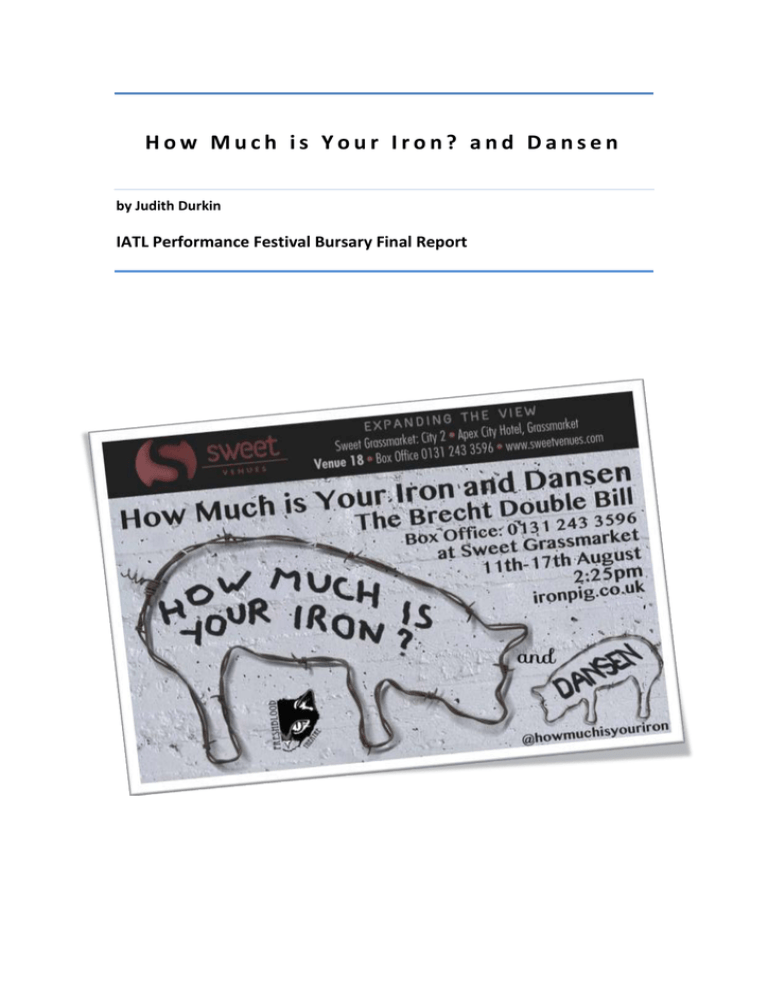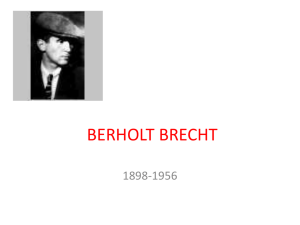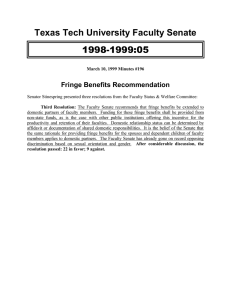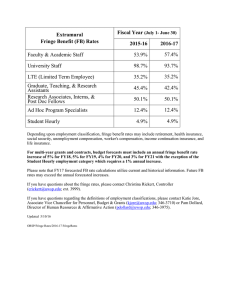H o w M u c h ... IATL Performance Festival Bursary Final Report by Judith Durkin
advertisement

How Much is Your Iron? and Dansen by Judith Durkin IATL Performance Festival Bursary Final Report Contents Page Contents Page ................................................................................................................ 2 The Project ..................................................................................................................... 3 Project Outline ...........................................................................................................3 Aims............................................................................................................................ 3 The Process .................................................................................................................... 4 Logistics ...................................................................................................................... 4 Rehearsals .................................................................................................................. 4 Research ..................................................................................................................... 5 Marketing ................................................................................................................... 6 The Fringe ...................................................................................................................... 8 Performing ................................................................................................................. 8 Advertising ................................................................................................................. 8 Watching Shows.........................................................................................................9 The Reflection .............................................................................................................. 10 Process ..................................................................................................................... 10 The Future ................................................................................................................ 11 Thank You................................................................................................................. 11 Appendices................................................................................................................... 12 Appendix One – The Norsen the Norwegian Dialogues ..........................................12 Appendix Two – Poster Design ................................................................................ 14 Appendix Three – Flyer Design, sides A and B ......................................................... 15 Appendix Four – Various images from marketing on the Royal Mile ...................... 16 Appendix Five – Press Release ................................................................................. 22 Appendix Six – Fringe Reviews ................................................................................. 23 The Project Project Outline It's Europe, 1936. Dansen sits with his pigs and contracts, safe and content. Svendson enjoys a respectable life selling iron and amiably trading with the neighbours. When their peaceful existence is disturbed by a mysterious stranger, friendship and morality is tested. As their neighbours get murdered one by one, they wonder who will be next… A double bill of Brecht's short texts 'How Much is Your Iron?' and 'Dansen', these plays display some of Brecht's forgotten writings and look at the lead up to World War Two. Freshblood Theatre’s ‘How Much is Your Iron?’ was the director’s own adaptation of Bertolt Brecht’s short plays ‘How Much Is Your Iron’ and ‘Dansen’. The adaptation was written to explore Brecht’s theatrical theories and techniques in relation to how they applied to his early work in opposition to his later, grander creations. Through the process of hybridisation (applying his later episodic style to his early, more demonstrative work) he created a new ‘lost’ Brecht play. Aims The aim of the project, while primarily to experiment with the performance of this ‘new’ Brecht play, was to experience Edinburgh and learn how to produce and direct a play in a semi-professional environment. Furthermore the cast were primarily second and first year Warwick students and as such we hoped that the experience would inform and expand their understanding and technical expertise in the form of practical theatre creation in the wider world. The platform of Edinburgh provides amateur theatre companies a wonderful opportunity with which to experiment and it was our hope that it would also provide the production team and cast of this project a platform from which to gain experience and launch theatrical careers, continuing this level of creativity after university. The Process Logistics While the venue had been agreed upon, we had to think about transporting props and the cast to Edinburgh, the logistics of storing the props and, indeed, of storing the cast! Get-ins and get-outs suddenly became an issue as it is widely known that Edinburgh gives you a very small window for these and you are charged extortionate prices for exceeding them. Rehearsals also became an issue as we shared a cast member with another play, performing the week before us in Edinburgh. This was further complicated by the news that we shared one performance day, and unluckily performance time too, with this play. With some negotiations the rehearsal schedule sorted itself out and after consultations with set designers from the various Warwick theatre societies we managed to re-design the set as both portable and easy to adapt and re-construct. The venue itself provided us with storage during the run. After taking into account the financial situations of the cast, accommodation was found in Edinburgh Napier University Halls which, though further from the centre of Edinburgh than most festival accommodation provided the cast with a comfortable living space that was, to their relief, distanced from the busyness of the fringe. The biggest issue that we had to face during this time, however, came down to the rights for the play. Though we had been in negotiations with the Brecht estate for months and had been given the go-ahead for the project, the Brecht estate contacted us in June revealing that the concept of a ‘Brecht adaptation’ was out of the question as the changing of any Brechtian work is completely forbidden by the estate. We discussed extensively how to rectify this problem: two of the cast members spoke German and so we entertained the possibility of completing our own translation but eventually the estate agreed that we could perform the plays side-by-side on the condition that we billed it as a ‘double-bill’ and changed the name to ‘How Much is Your Iron? and Dansen’. The process was arduous and very tedious at times, we couldn’t help but wonder why the project had been agreed upon only to be denied two months later. It was also of great sadness to the production crew and cast that a project that we felt would have been supported by Brechtian ideals should be denied emphatically by his descendants. Rehearsals A note from the director: In our rehearsals we attempted to take influence from Brechtian techniques whilst remaining conscious of the reactive, performative nature of performing a piece that is now more of an historical showpiece than the political commentary it was written as. Whereas the original would have ideally been performed as a creation designed to inspire action in the audience over contemporary injustices, now it is a curiosity, a retrospective on the opinions of the past, and as such a less demonstrative and a more romantic, historicised style of performance was required. Initially we worked on demonstrative style of physicality. Emphasising awareness of the audience and clarity of message. Then we developed into a more internalised performance of character, embodying personality through physicalisation and conscious manipulation of individual body parts and gait. After establishment of character and technique was finalised, we studied the script with a fine tooth comb to establish exact interpretations of meaning and audience interface to make sure our performance was polished and intelligently conveyed. Naturally, we emphasised social construction within the cast to allow the easy flow of ideas and close personal knit of interaction. We played standard drama and ‘getting to know you’ games throughout performance and rehearsal and wound up with a amicable, affectionate and co-operative cast that worked happily and productively with an exceptional attitude towards each other and the production as a whole. Research In our discussions with the Brecht estate they had found it very difficult to discover who owned the rights to the ‘Dansen’ portion of the play, necessary in order for us to purchase said rights. It came to light that the play had never been performed in English and the estate were unsure as to whether it had ever been performed in German either. We realised that we had on our hands what was potentially the last ever premier of a Brecht play. We began to research the two plays in order to properly exploit this discovery. Our fascinating research is outlined below: “Originally titled ‘Little Deals in Iron’, ‘How Much is Your Iron?’ was written by Brecht in 1939 while he was in exile in Sweden as he witnessed the approach of the World War Two. As a result the play forms a close examination of Sweden’s role in the lead up to the Second World War. Little is known about Brecht’s ‘Dansen’, but for it may have been started before Brecht left Denmark for Sweden in April of 1939, intending it to be performed by a Danish workers’ theatre group. ‘Only How Much is Your Iron?’ was actually performed during Brecht’s lifetime in a mixed Swedish/Danish translation. Brecht was not supposed to take part in any political activities while living in Sweden and therefore gave the author’s name ‘John Ken’. ‘While How Much is Your Iron?’ has rarely been performed, research has shown us that the play ‘Dansen’ has, it is believed, never yet been performed in English, making this play quite possibly the last ever premier of a Brecht play in the United Kingdom. These productions are, however, unique for another reason. Despite being written as two separate one-act plays, ‘How Much is Your Iron?’ and ‘Dansen’ share a character, the mysterious stranger, and the principal characters frequently converse with each other, in the different plays, through monologues. In performing the plays as a double bill, the connection between the two gains dramatic depth, and it is on this premise that we have produced these two plays to be performed side-by-side. Additionally another Brecht fragment scene suggests that Brecht had intended for there to be a third playlet in what we see to be a ‘Brechtian series’, a playlet set in the house of Norsen the Norwegian. In the short play both Dansen and Svendson call on Norsen amidst the sounds of thunder and the glow of a fire. The Stranger also makes a reappearance in this piece. The Norsen piece, unfortunately, was never finished. We have, however, found three brief dialogues that appear to be a framework for the Norsen piece.1” In addition to the above research we later discovered that a production of ‘Dansen’ had been directed by Hans Gagler in 1967 and performed once in Germany alongside ‘Was kostest das Eisen?’. Interestingly this was also a double bill produced but this time named ‘Dansen I and II’. This piece was the only record we were able to find of ‘Dansen’ being performed and as such the idea of our ‘Dansen’ as the ‘last ever premier of a Brecht play in the UK’ became a powerful marketing tool for the production in addition to a fascinating story carrying the production forwards. Indeed we even created programs for our audience with the story on the reverse, hoping that, with some background, the production would be even more well received. Marketing A note from the marketing manager: Our marketing design was given a difficult brief. Trying to bring in a mass audience at a fringe festival, selling the comedy aspect of an historical drama, and establishing modern elements to a WWII drama demanded a difficult balance of edgy and approachable; respectful, but creative. In the end we decided to play off the two larger aesthetic themes of the set: pigs and barbed wire. This gave a sinister tone to the piece; the barbed wire, whilst evoking historical elements and a sense of humour when combined with the image of a pig. The pig also symbolised, just as it did in Brecht’s writing, a sense of vulnerability; a fattened animal, livestock to the slaughter.2 Using these graphic themes we also considered our unique selling points that were easily conveyed through the media of posters and flyers. We were performing the only registered Brecht play at the fringe, and were quite possibly performing the last premier of a major work of Brecht’s writing. However we could not quite claim in all certainty that we were definitely the last ever Brecht premiere. After some debate 1 2 See appendix one See appendix two as to how to advertise a fact we weren’t entirely certain of, we managed to create a piece of promotional material that satisfied our appeal, and the fringe festival’s taste for ironic humour.3 Once our promotional material was created, we began work on the production website, carefully designed, utilising our production photos and the research on the production done by the director and producer, we created a series of pages that provided information and interest to the casual reader – www.ironpig.co.uk. 3 See appendix three The Fringe Performing Sweet Venues’ International 1, our performance space, was excellent. A professionally run establishment, our fears over lack of get-in and get-out times were unfounded as the venue provided us with ample set-up time and a thorough (albeit exhausting - it was at 1am!) tech rehearsal. Located inside the Apex International Hotel on Grassmarket the venue was in a relatively central location, though it could have been closer to the Royal Mile. Furthermore by providing us with a dressing room, props storage space and use of the very comfortable lobby and bar the venue was welcoming and friendly which definitely helped to attract audience members. Our problem with the venue arose however, with the fact that Sweet Venues is fairly new to the Fringe. Unlike establishments such as C Venues or Spaces UK, Sweet is relatively unknown and therefore bringing in audience members was left to advertising on the day rather than the ‘pull of the venue’. The venue marketing manager, however, was extremely knowledgeable and by introducing us to resources such as the Fringe ‘Half Price Hut’ (tickets are sold at half price) and ‘code words’ (with a special password audience members are given a buy-one-get-onefree discount) we steadily boosted audience numbers during the week. With an Fringe wide average attendance of four spectators per performance, our average of twenty was a great achievement! Unfortunately with a venue capacity of one hundred we always felt a bit under sold. Advertising A note from the marketing manager: Upon arrival at Edinburgh we began to establish our brand identity and public awareness within the festival. Going out to the Royal Mile, Grassmarket, and Princes Street to flyer, with the cast in costume, we attempted to ensure our presence at the fringe would be a memorable one for both ourselves and our audience. 4 We agreed a deal with the Fringe Office’s ‘Half Price Hut’ to allocate thirty tickets per performance to discount and posted promoters around the hut to raise awareness of the deal. On the Royal Mile we had our cast in costume performing sections from the play and improvised games such as Kung Fu Ninja and Manhunt, attracting attention and increasing a sense of community between ourselves and other performers. We made agreements with casts from other shows that we met at the fringe to visit their shows in exchange for their watching ours, and handed out nearly 5,000 flyers in a six day period. 4 See appendix four Watching Shows In addition to our daily performances and marketing stints on the Royal Mile the cast and production crew took every opportunity to watch as much theatre as possible, often going home to rest after the show in order to be able to watch other productions into the small hours of the morning. Highlights included various Belt Up Theatre productions, in particular their ‘Outland’, Elephant and the Mouse’s ‘Repertory Theatre’ (hailed by some of the cast to be the best production they had ever seen), Showstopper’s Improvised Musical and ‘One Man Star Wars’ at Udderbelly. Seeing the theatre on offer at the Fringe not only motivated the cast to work harder at their own show, but revealed to the entire production team what was actually possible with an Edinburgh show. Productions such as Donnacadh O'Bruain’s ‘Peep’ inspired and encouraged all who watched it to think outside the box (quite literally – the production was set inside a portable crate...) with regards to what is possible at the Edinburgh Fringe. The Reflection Process The process of taking a show to the Edinburgh Fringe has been invaluable. Time management over such a long period with so many aspects to co-ordinate is, I’ve learnt, only something that comes with practice and producing a play at the Fringe has definitely helped. As a producer you feel directly responsible for the welfare and enjoyment of the cast, many of whom, in our case, were experiencing Edinburgh for the first time. The multi-tasking required before, during and indeed after the Fringe is a skill that will serve me very well in the future. Furthermore the tactical nature of marketing a show in a festival in which you are competing with so many other wellreviewed productions is a great challenge that results in a huge sense of accomplishment when the audience members start rolling in. Last but not least the financial side of Edinburgh can often be a big burden. Many theatre companies comment that Edinburgh is a financial black hole and being able to experience keeping a show afloat in such an environment has been both challenging and extremely educational. Reviews Having been instructed by the venue on how best to write a press release, we composed our own release and sent it out to the Fringe Media List, sending, in total, nearly two hundred emails.5 The aim was to receive as many reviews as possible. In total we attracted four reviewers including The Morning Star, the British left-wing newspaper who talked to the director after the production, listing it as the only piece of interesting political theatre at the Fringe! In addition to solid reviews from Broadway Baby, Fringe Review and Theatre is Easy, we were featured in an article in The Independent and on a top Fringe blogger before the start of the Fringe.6 While reviewers tended to prefer the ‘How Much is Your Iron?’ portion to the ‘Dansen’ section, most enjoyed the show and the concept and, perhaps most importantly, listed us as a company to watch in the future. Furthermore upon leaving the venue the cast and production team were complimented by both the venue manager and technical manager on being the most organised, well-run and professional company they had ever seen in their venue. All in all we were very pleased with the reception of the play and proud that we had achieved in producing a successful Edinburgh Fringe production. Both the director and I will take away from this the comment that we are ‘a company to watch’ and use it to inspire future, and perhaps more daring, Fringe productions. 5 6 See appendix five See appendix six The Future A note from the director: The legacy we wished to leave for the future was a respectable name for Freshblood Theatre at the Edinburgh Fringe, and an enthusiastic young cast and crew who would push to take Freshblood shows to the festival in the future. It seems that all the cast enjoyed their experiences in our production tremendously, and already on the cast and crew facebook group members are discussing productions for next year’s Fringe. With a series of respectable reviews and being dubbed ‘a company to watch’, hopefully Freshblood has benefited from our endeavours in the professional world. We also wanted to take time to learn the inside operation of the festival in order to learn how to take bigger and better productions to Scotland in the future. The entire process was a huge learning experience. Being in an artistic community in which creativity meets financial necessity was invaluable in order to learn the proper balance of progress and conservation; to measure one’s creative instincts for the benefit of an audience and performer. With the benefit of hindsight we may have been able to take more creative risks as a company, and now knowing how the fringe operates we may have been able to create more ‘buzz’ around our brand earlier in our run to boost audience numbers. However, our production was creative and interesting, and our audience numbers were not disappointing. In short, we have an excellent grounding from which to expand our ideas and our expertise, ready for next year’s fringe and many more to follow. Thank You We greatly appreciate everything that IATL have done for us in allowing this production to happen and we hope that this report begins to highlight what a wonderful journey this project has been and how much it has helped everyone who took part in it. Thank you! Appendices Appendix One – The Norsen the Norwegian Dialogues Three Brief Dialogues Two Scandinavians sitting over breakfast. 1 THE OPTIMIST: You are an incorrigible pessimist. THE PESSIMIST: And you are an incorrigible optimist. THE OPTIMIST: If only you wouldn’t always turn up here with your prophecies just as I am sitting having a meal! THE PESSIMIST: When else am I to turn up? You’re always sitting having a meal. THE OPTIMIST: But every time I listen to you I lose my appetite. THE PESSIMIST: Mine goes every time I see you. THE OPTIMIST gives an irritated grunt. THE PESSIMIST: It’s bound to end badly. Look at what has happened. THE OPTIMIST: What has happened? THE PESSIMIST: Shall I tell you a little story to remind you? Eh? THE OPTIMIST: All right. 2 THE PESSIMIST: Was that, or was that not how it was? THE OPTIMIST: An extremely pessimistic view. And a very uncharitable picture of Dansen. Not a word about his undisputed love of freedom, etc., etc. THE PESSIMIST: My dear fellow! I was positively flattering Dansen. Now comes his big moment. THE OPTIMIST: Really? That sounds promising. THE PESSIMIST: Let me just got on with the story. 3 THE OPTIMIST: Well? THE PESSIMIST: Well what? THE OPTIMIST: Well, what’s wrong with that contract? Suppose I go on with the story this time? I’ll show you how the contract is going to work out. You’ll be amazed. THE PESSIMIST: I certainly will. Just watch out! Appendix Two – Poster Design Appendix Three – Flyer Design, sides A and B Appendix Four – Various images from marketing on the Royal Mile Appendix Five – Press Release For Immediate Release Freshblood Theatre Presents How Much is Your Iron? and Dansen A double bill of Brecht’s forgotten plays and probably the last ever premiere of a Brecht play in the United Kingdom It's Europe, 1936. Dansen sits with his pigs and contracts, Svendson enjoys a respectable life selling iron. When their peaceful existence is disturbed by a mysterious stranger, friendship and morality are tested. As their neighbours are murdered one by one, they wonder who will be next… This could be the last chance to see a premiere of a Brecht play, as it is believed that Dansen has never yet been performed in English. By performing the productions as a double bill, hitherto unrealised connections between the two plays are realised: How Much is Your Iron? and Dansen fascinatingly share a character, the mysterious stranger, and the principal character in each play converse with each other, between the different plays, through monologues. How Much is Your Iron? and Dansen tell the story of the build-up to World War II through the eyes of the Swedish and Danish nations, each represented by a single character. This is a unique double bill of Brecht’s forgotten writings, blending his trademark dark humour with an innocence that is unique to his early experimental writing for the stage. Incorporating historical drama and comedy at its darkest, How Much is Your Iron? and Dansen is unique, original and unprecedented in its presentation and creativity. Freshblood Theatre is an amateur company that works closely with the Warwick Arts Centre and, as a company dedicated to encouraging new and innovative writing and ideas from emerging playwrights, was awarded both the Warwick Clive Barker Award in 2011 and the IATL Festival Grant in 2012 for the preview run of this show. Venue: Sweet Grassmarket, Apex International Hotel, Venue 18 Dates: Aug 11th-17th Times: 14:25-15:25 Ticket Price: £7.00 (£5.00) Box Office: 0131 243 3596 Website: www.ironpig.co.uk Appendix Six – Fringe Reviews Pre-fringe blog article (bottom of the page): http://vilearts.blogspot.co.uk/2012/07/its-war.html Pre-fringe Independent article (bottom of the page entitled ‘JKR and the Brechtian curse’): http://www.independent.co.uk/news/people/diary/the-feral-beast-govestuck-in-with-their-pals-8007757.html Morning Star review: http://www.morningstaronline.co.uk/news/content/view/full/122707 Fringe Review review: http://www.fringereview.co.uk/fringeReview/5012.html Broadway Baby review: http://www.broadwaybaby.com/~broadway/listing.php?id=14441 Theatre is Easy review: http://www.theasy.com/Reviews/Edinburgh/2012/howmuchisyouriron.php




